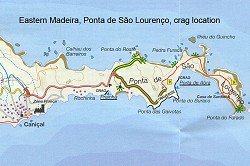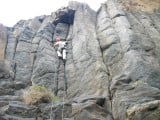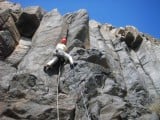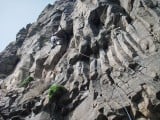
The Atlantic isle of Madeira lies off the African coast some 250 miles north of the Canary Islands. Rising to 1800m, it is a mountainous island criss-crossed with artificial watercourses called Levadas, which offer very scenic yet level walks and are popular with walkers from all over Europe. The island is surrounded by massive sea-cliffs of 'volcanic ash', up to 578m high, but not surprisingly there has been little or no attention from climbers.
With an eye to attempting some of the many sea stacks on the Madeira's north coast, Steve Sustad and I paid a visit this February. Mountainous seas on the north coast throughout the week put paid to any attempts on the stacks, however good climbing was found on the sheltered southern coast, most notably on the long peninsula of Ponta de São Lourenço which forms the eastern tip of the island. The rock is relatively firm basalt, and typical of that rock it offers many excellent crack, groove and corner lines.
The first crag explored was in the sheltered sandy cove of Prainha, just 5 minutes walk from the car. This 25m-high crag would be unbearably hot in summer but gave perfect climbing conditions in February. Six routes were climbed ranging from HVS to E4, all on-sight. Some fine harder lines await attention but these may require abseil inspection.
One km east of Prainha is a newly-built resort, beyond which an almost continuous line of cliffs runs out to the peninsula. This area gave some really enjoyable sea-level traversing, extending as far as the next crag to give worthwhile routes – a bigger (35m) and more imposing wall within the open bay of Porta de Abra. This crag is 10 minutes walk from the car park at the road head of Ponta de São Lourenço – take the main path for 7-8 minutes then veer right. It is best to fix an abseil rope to reach the base (the descent gully on the east side is rather gripping). Two routes were climbed here, each two pitches long. Towards the right an obvious entry followed by a rising traverse gave the pleasant line of Brisa (E2 5b) (breeze) at E2 5b. This was climbed in perfect conditions under clear blue skies. The left side of the cliff is more columnar in structure and gave a more challenging route Tempestade (E4 6a) E4, 6a, 5c. Halfway up this a storm hit, causing tornado-like winds which whipped up the sea even in the sheltered bay and lashed the crag with spray. We were pinned down under overhangs for half an hour and buffeted all ways. Eventually conditions improved and we were able to complete the route. As at Prainha, some excellent challenging lines remain to be climbed on this crag.
Madeira will never be an important destination for climbing, but climbers going there for the walking or just a winter sun break would do well to pack some climbing gear, even if only a pair of comfy rock shoes for the sea-level traversing.
Logistics
When to Go
The crags we visited would be fine all through the winter months. The summer months may be too hot although there are some 'mountaintop' crags to explore if you do happen to visit then. Due to the warmer water and calmer seas, October/November is probably best for the north coast sea stacks.
How to get there
The best option is to get a package deal from one of the usual tour operators
Accommodation Advertise here
No Premier Listings found in this area
We booked a half-board deal on the internet which turned out to be pretty cheap (roughly the same cost as B+B in the UK.) The A car is pretty much essential for getting around. Try Travel Supermarket as they generally search out competitive car hire rates.
Other Activities
Madeira is famous amongst most due to its beautiful walking terrain. The Madeira-web site is a good general resource for finding out about the island.
Instructor/Guides Advertise here
No Premier Listings found in this area
About the author - Pat Littlejohn
Director of the International School of Mountaineering based in Leysin, Switzerland, Pat is a man of modest character and immense achievement. Pat is perhaps best known as creator of some of the UK's most memorable climbing voyages on superb and virgin cliffs lurking in remote and beautiful environments. Mention a Littlejohn route, and the word that most often comes to mind is 'commitment'. These are truly world-class adventure routes, often on remote sea-cliffs, usually climbed completely on sight into the unknown.
Pat has created new routes in many areas of the world, often at unconventional venues. Book Of Genesis in the Grand Canyon climbed in 1978 is an early example, the first serious free climbing in the Canyon. In 1991 he made the first free climb on the west face of Point John on Mt Kenya, an 11-pitch E5. In the Alps numerous first free ascents of climbs such as the South Face of the Fou. His 1995 new route on Taweche in Nepal with Mick Fowler was an epic affair with 43 technical pitches, desperate bivvies, little food and achieved over eight days in ultra-lightweight alpine style. With a sense of humour, too.
Pat's approach to climbing is clearly defined. He is totally convinced that the ground-up onsight approach is by far the most rewarding climbing experience to be had. He has also been prepared to speak out about the destruction of the adventure climbing ethic in the Alps. "If we allow the sport-climbing approach free rein in the mountains, we may wake up some day to realize that we've sold out our unique sport for... a synthetic substitute, offering virtual adventure where once we had the real thing."
For more information on The International School of Mountaineering:www.alpin-ism.com
- IN FOCUS: Culm Dancing - A Second Wave (1968-73) 11 Mar, 2021
- ARTICLE: Pat Littlejohn's Explorations in North Wales 23 May, 2017
- Pat Littlejohn - What has Climbing done for you? 25 Mar, 2008
- ARTICLE: Your First XS 29 Nov, 2007



















Comments